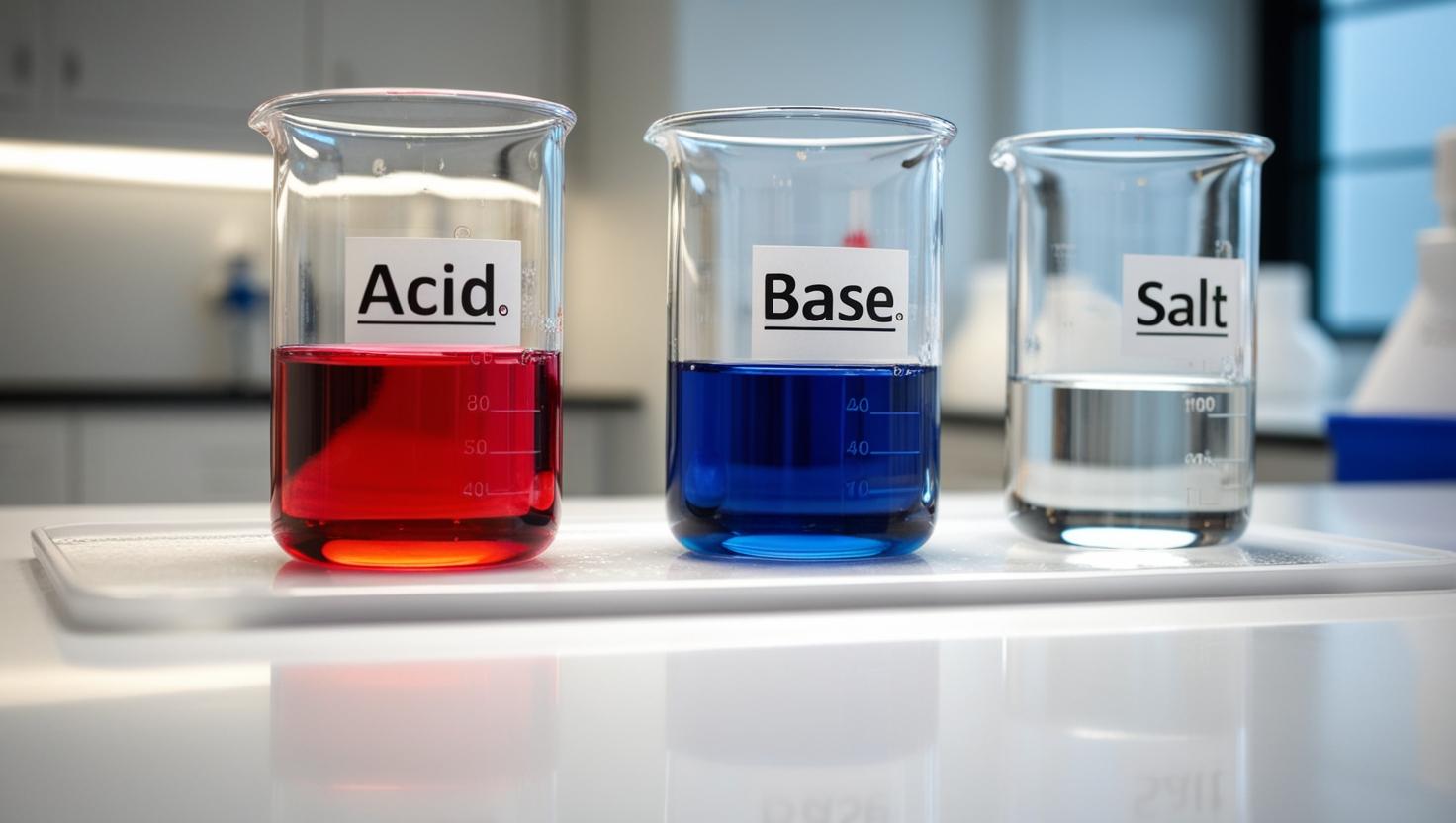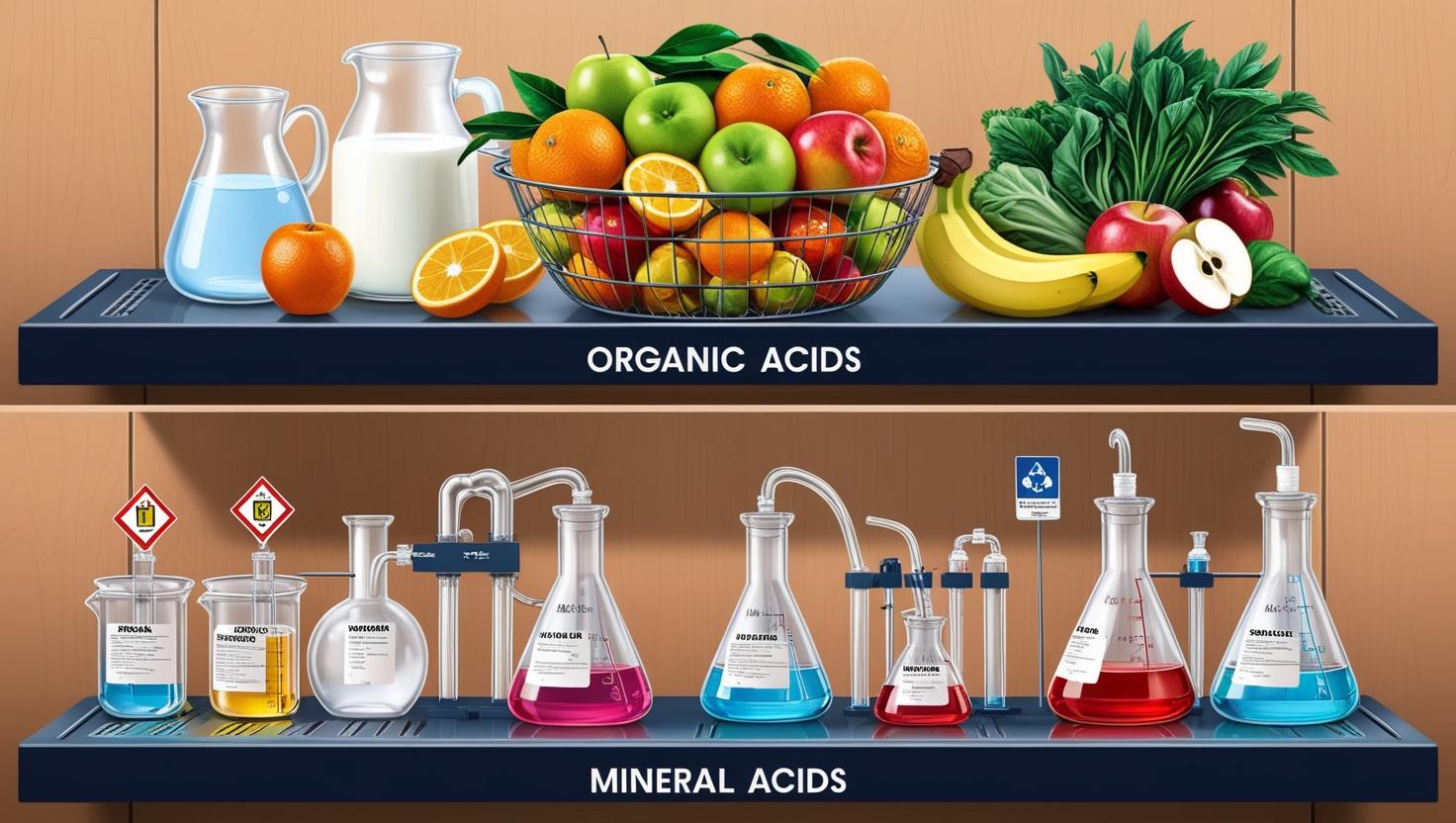Acids, Bases, and Salts
Acids, Bases, and Salts – A Complete Guide
Chemistry is an inevitable part of human life. Chemistry is involved in everything, including the food we eat, the medicines we take, the cleaning products we use, the air we breathe. Acids, Bases, and SaltsAre among the most significant of the endless sea of chemical compounds that constitute everyday living.

Have you ever wonder why lemons come sour, or soap feels slippery Have you ever wondered why vinegar burns acutely when it comes into contact with an open wound? These common experiences relate to the properties of acids & bases.
Acids, bases, and salts are extensively used in various fields including food preservation, agriculture, construction, and medicine. Knowing their characteristics, reactions and uses helps comprehend their significance in science & everyday life.
We are going to discuss is about:
- Acids – their properties, examples, and uses.
- Bases – their characteristics & applications.
- Salts – their formation & significance.
- The pH scale and indicators – how we measure acidity & basicity.
- The role of acids, bases, and salts in real-life applications.
By the end you will have a comprehensive grasp of these core chemical compounds & their real-world uses.
Definition of Acids
An acid is a substance that produces hydrogen ions (H⁺) in water. Acids taste sour, are corrosive, and react with metals and bases because of the presence of H⁺ ions. Acids are marked by a pH under 7 & would alter blue litmus paper red.
Types of Acids
1. Organic Acids (Natural Acids)
Plants and animals contain organic acids. They are relatively weak & less corrosive than mineral acids. Common organic acids include:
-
Citric Acid (C₆H₈O₇):
Commonly found in lemons, oranges & other citrus fruits.
-
Acetic Acid (CH₃COOH):
The main component of vinegar.
-
Lactic Acid (C₃H₆O₃):
Source: Sour milk & yogurt during vigorous exercise
-
Oxalic Acid (C₂H₂O₄):
Found in spinach, rhubarb & beets.
-
Tartaric Acid (C₄H₆O₆):
Found in tamarind & grapes.

2. Mineral Acids (Inorganic Acids)
Mineral acids are those which are strong and they are used in factories and laboratories. Some common examples include:
- Hydrochloric Acid (HCl): Found in stomachs to help you break down food for absorption; also found in cleaning agents.
- Sulfuric Acid (H₂SO₄): Required for car batteries, detergents, and fertilizers.
- Nitric Acid (HNO₃): Used in the production of explosives & fertilizers
- Phosphoric Acid (H₃PO₄): Found in soft drinks, used in fertilizers.
Properties of Acids
- Sour taste (like lemon or vinegar).
- Corrosive – can burn the skin & react with metals.
- Conduct electricity in aqueous solution.
- Turn blue litmus paper red.
- React with metals to form hydrogen gas.
- React with bases to form salt and water (neutralization reaction).
- Have a pH below 7.
Uses of Acids
- Hydrochloric acid helps digestions & is used in cleaning.
- Sulfuric acid are used in car batteries, paints, and fertilizers.
- Acetic acid in cooking & food preservation.
- Citric acid is used in food, medicines, and cosmetics.
- Nitric acid is used in explosives & fertilizers.
What are Bases?
Definition of Bases
Bases are substances that release hydroxide ions (OH⁻) into water. They neutralize acids, taste bitter, and feel slippery (like soap). Bases will make red litmus paper turn blue & have a pH value greater than 7.
Types of Bases
1. Strong Bases
Strong bases are very reactive and dissociate completely in water. Examples include:
-
Sodium Hydroxide (NaOH): Used in soap-making & drain cleaners.
-
Potassium Hydroxide (KOH): Used in fertilizers and batteries.
-
Calcium Hydroxide (Ca(OH)₂): Used in cement & neutralizing acidic soil.
2. Weak Bases
Weak bases also partially dissociate in water and are less reactive. Examples include:
-
Ammonia (NH₃): Used in household cleaners & fertilizers.
-
Magnesium Hydroxide (Mg(OH)₂): Used in antacids.
-
Aluminum Hydroxide (Al(OH)₃): Used in deodorants.
Properties of Bases
- Might smell like ammonia or bleach.
- The fingers pass slickly over the surface (as with soap).
- Conducts electricity when in aqueous solution.
- Turn red litmus paper blue.
- Acids enter to form salt and water.
- Have a pH above 7.
Uses of Bases
- Sodium hydroxide in soap and detergents.
- Ammonia has many uses, including in fertilizers and household cleaning.
- Calcium hydroxide will find usage in construction & also in soil treatment.
What are Salts?
Definition of Salts
Salts are Ionic compounds which are formed from the reaction of acid & base in neutralization. The positive ion (cation) is due to the base, and the negative ion (anion) is due to the acid.
.png)
Types of Salts
-
Normal Salts – when all the acidic hydrogen are replaced.
-
Sodium Chloride (NaCl): Common table salt.
-
Potassium Nitrate (KNO₃): Used in fertilizers.
-
Acidic Salts – Contain replaceable hydrogen atoms.
-
Sodium Bisulfate (NaHSO₄): Used in industrial cleaning.
-
Basic Salts – Contain hydroxide ions (OH⁻).
-
Zinc Hydroxychloride (ZnOHCl): Used in medicine.
Uses of Salts
- It is used in cooking & food preservation.
- Calcium carbonate is used in making cement and glass.
- Potassium nitrate is used in gunpowder & fertilizers.
The pH Scale and Indicators
So the pH scale simply scales the acid or base status of substances:
- pH 0-6: Acidic
- pH 7: Neutral (e.g., pure water)
- pH 8-14: Basic
Indicators – How to Identify Acids & Bases
-
Litmus Paper:
-
Red in acid
-
Blue in base
-
Phenolphthalein:
-
Colorless in acid
-
Pink in base
-
Methyl Orange:
-
Red in acid
-
Yellow in base
Additional Information on Acids, Bases, and Salts
1. The Role of Acids and Bases in Human Body
Acids and bases play an important role in biological processes too as they help maintain the pH level of the body & help in metabolic processes.
-
Hydrochloric Acid (HCl) in the Stomach:
-
Assist with digestion & disassemble food
-
HOW DOES IT WORKS Kills bad bacteria in the stomach.
-
Key to high acidity required for enzyme function.
-
Carbonic Acid-Bicarbonate Buffer System:
-
Keeps blood pH around 7.4.
-
Helps regulate the pH and prevents acidosis (low pH) and alkalosis (high pH).
-
Carbonic acid (H₂CO₃) & bicarbonate ions (HCO₃⁻) regulate pH.
-
Amino Acids and Protein Structure:
-
Proteins are strings of molecules called amino acids, which contain both acidic (-COOH) & basic (-NH₂) groups.
-
Graph showing the influence of body pH on protein folding & enzymatic activity.
-
Salts in the Human Body:
-
It is used in conjunction with sodium chloride (NaCl).
-
Potassium chloride (KCl) is responsible for regulating nerve function.
-
Bone & teeth are strengthened by calcium phosphate (Ca₃(PO₄)₂.
2. Acids, Bases, and Salts in the Food Industry
Many food processing and preservation methods depend on different acids, bases, and salts.
-
Acids in Food:
-
Citric Acid (C₆H₈O₇) – Used in soft drinks, jams, and candies.
-
Acetic Acid (CH₃COOH) – Preserves pickles and adds flavor.
-
Tartaric Acid (C₄H₆O₆) – Used in baking powder.
-
Bases in Food:
-
Sodium Bicarbonate (NaHCO₃) – Baking soda, used for fluffy cakes.
-
Calcium Hydroxide (Ca(OH)₂) – Used in tortillas to make corn digestible.
-
Salts in Food:
-
Monosodium Glutamate (MSG, C₅H₈NO₄Na) – Enhances food flavor.
-
Sodium Benzoate (C₆H₅COONa) – Preservative in soft drinks & sauces.
3. Advanced Industrial Applications of Acids, Bases, and Salts
Acids in Industry
-
Sulfuric Acid (H₂SO₄):
-
Used in petroleum refining, fertilizers, and battery production.
-
Key component in making detergents & dyes.
-
Nitric Acid (HNO₃):
-
Used in making explosives (TNT, dynamite).
-
Helps in etching metals for electronics.
-
Phosphoric Acid (H₃PO₄):
-
Used in fertilizers to increase crop yield.
-
Added to soft drinks to enhance taste.
Bases in Industry
-
Sodium Hydroxide (NaOH):
-
Used in soap-making & paper production.
-
Helps in textile processing to soften fabric.
-
Ammonium Hydroxide (NH₄OH):
-
Used in fertilizers to supply nitrogen to plants.
-
Found in household cleaners & disinfectants.
Salts in Industry
-
Sodium Carbonate (Na₂CO₃) – Washing Soda:
-
Used in glass manufacturing.
-
Removes stains & grease from fabrics.
-
Calcium Chloride (CaCl₂):
-
As a de-icing agent on roadways.
-
Assistance to preservation of packaged food.
-
Potassium Nitrate (KNO₃):
-
Used in explosives and fireworks.
-
Translated from shit: fertilizer.
4. Environmental Impact of Acids, Bases, and Salts
Acid Rain – Causes and Effects
-
From burning fossil fuels that emit sulfur dioxide (SO₂) and nitrogen oxides (NOₓ).
-
Those gases combine with water to make sulfuric acid (H₂SO₄) & nitric acid (HNO₃).
-
Cause harm to crops, forests, aquatic life, and buildings.
Alkaline Pollution
-
Industrial waste with high pH (strong bases such as NaOH, KOH) can damage aquatic ecosystems.
-
Soil fertility & plant growth get affected.
Salt Accumulation in Soil
-
When KNO₃, NaCl are anabolic exaggerated the soil salinity.
-
This decreases water absorption in plants & ultimately decreases crop yield.
-
What are their solutions: Crop rotation, proper irrigation, and soil testing.
5. How Acids, Bases, and Salts Are Used in Medicine
-
Antacids (Bases Neutralizing Acids in the Stomach)
-
Magnesium Hydroxide (Milk of Magnesia): Treats acid reflux.
-
Sodium Bicarbonate (Baking Soda): For relief of indigestion.
-
Acidic Medications
-
Acetylsalicylic Acid (Aspirin): Anti-inflammatory effects & Analgesic.
-
Ascorbic Acid (Vitamin C): Immune booster.
-
Salts in Medicine
-
Oral Rehydration Salts (ORS): This helps to avoid dehydration.
-
Sodium Fluoride (NaF): Actively Used in Toothpaste to Help Combat Cavities
6. Neutralization Reactions in Everyday Life
An acid-base or neutralization reaction is when an acid and a base react to produce salt & water.
Examples of Neutralization in Daily Life
-
Antacid for Heartburn:
-
HCl (stomach acid) + Mg(OH)₂ (antacid) → MgCl₂ + H₂O
-
It helps in relieving acidity & Indigestion.
-
Lime (Ca(OH)₂) in Agriculture:
-
Neutralizes acidic soil to improve fertility.
-
Baking Soda in Cooking:
-
Acid (vinegar) + Base (baking soda) → Carbon dioxide gas (used in baking).
-
Soap Production (Saponification):
-
Fat + NaOH (base) → Soap + Glycerol.
7. How pH Affects Daily Life
pH is crucial in various fields:
- Swimming Pools: pH 7.2-7.8 prevents foaming of water, eye and skin irritation
- Skincare Products: Balanced pH prevents acne & irritation
- Agriculture: Soil pH determines what crops grow best.
- Water Purification: acid neutralization removes hazardous substances.
Conclusion
- Acids are sour in taste and have a low pH.
- Bases are bitter, slippery, and have a high pH.
- Salts are neutral compounds formed when acids and bases react (neutralization).
- The pH scale helps us measure how acidic or basic a substance is.
- pH indicators help us identify the nature of a substance (acid, base, or neutral).
- Acids, bases, and salts play important roles in everyday life—like in food, medicine, cleaning, and farming.
CBSE Schools In Popular Cities
- CBSE Schools in Bangalore
- CBSE Schools in Mumbai
- CBSE Schools in Pune
- CBSE Schools in Hyderabad
- CBSE Schools in Chennai
- CBSE Schools in Gurgaon
- CBSE Schools in Kolkata
- CBSE Schools in Indore
- CBSE Schools in Sonipat
- CBSE Schools in Delhi
- CBSE Schools in Rohtak
- CBSE Schools in Bhopal
- CBSE Schools in Aurangabad
- CBSE Schools in Jabalpur
- CBSE Schools in Jaipur
- CBSE Schools in Jodhpur
- CBSE Schools in Nagpur
- CBSE Schools in Ahmednagar
- CBSE School In Tumkur











